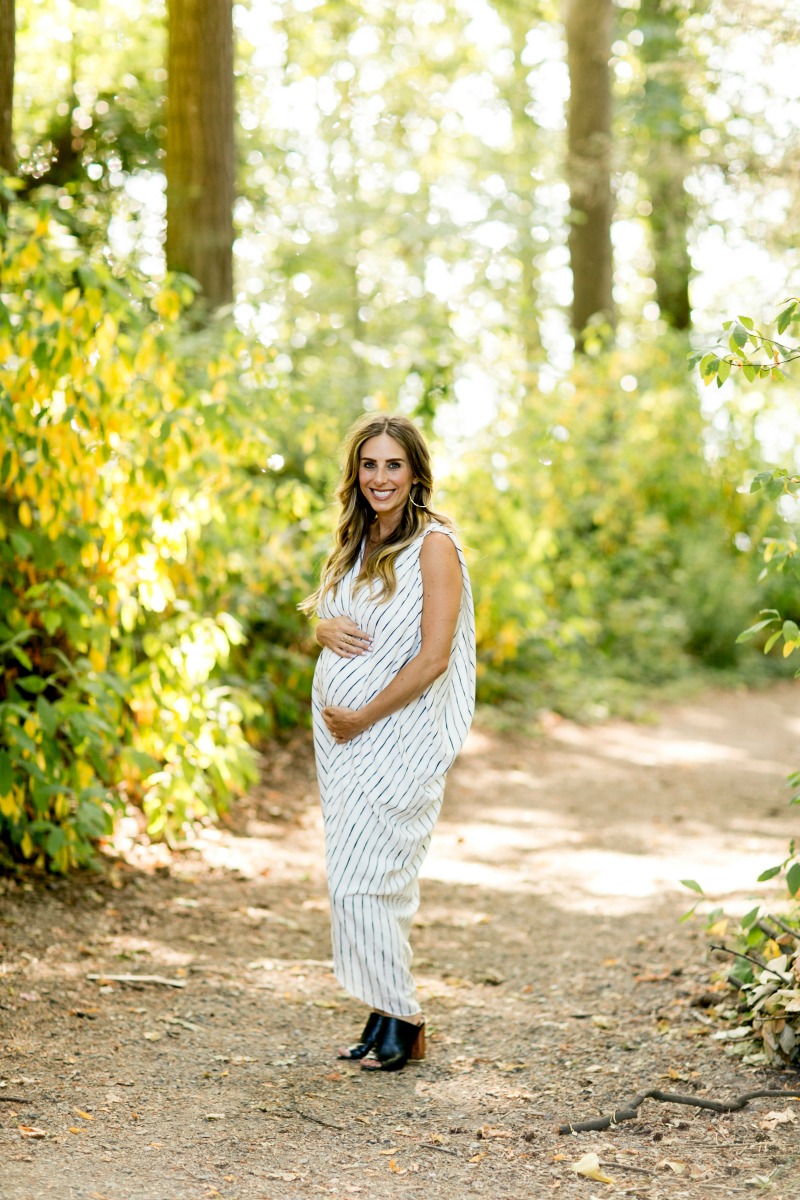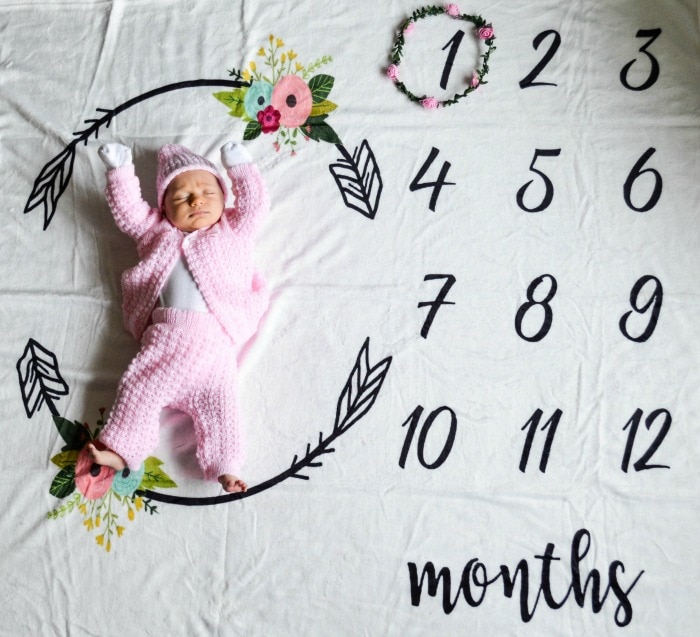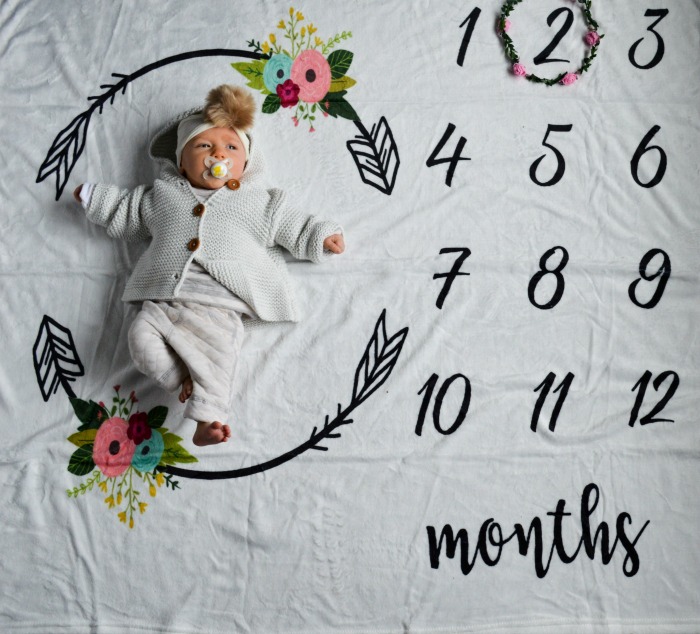There is nothing quite like being pregnant. The range of changes I experienced — physical, mental, emotional, hormonal — were vast and volatile. At times it seemed to stretch forever and yet it was over in the blink of an eye.

My first trimester brought on intense nausea and exhaustion paired with a combination of elation, excitement and anxiety. There was a lot of fear getting through those first 12 weeks, which is when the rate of miscarriage is highest. In my mind it was a “hurdle” to get through, to make it to the next phase when I knew the baby was safe and healthy and I felt confident enough to finally be able to share the news with everyone.
Looking back I wish I would’ve trusted the process more, and not let fear have such a grasp over me. If I choose to have another baby (and am lucky enough to do so) I think I’ll be much more open about it and allow myself to celebrate early on!
Second Trimester Was a Dream
For the most part my second trimester was a dream. My nausea cleared up and I began craving my normal healthy foods that I couldn’t think of stomaching first trimester. I had been living off of (gluten-free) pizza, pasta, oatmeal and toast. Thankfully, I regained my energy and was relieved to know our baby was healthy and I could share our big news with everyone.
I also loved when I started showing — right around the 20 week mark. This made me feel creatively inspired and had a ton of awesome work opportunities. It was summer in the PNW and my hubby and I took advantage of the beautiful weather with a variety of getaways, including lots of hiking, backpacking and camping trips which I felt grateful to feel good enough to do while pregnant.
Second Trimester Glucose Test
Right around the end of my second trimester, I went in for the customary (and dreaded) glucose test. It’s a two hour process where you fast 12 hours beforehand, then drink an unappealing, sugary drink and get your blood drawn one hour and two hours post-consumption. The purpose is to make sure your pancreas is able to keep up with the hormonal demand for insulin, and that ultimately you’re producing enough insulin to keep your blood sugar as well as your baby’s in check. Other than it being a nuisance of a test, I didn’t think twice about it.
As a nutrition coach, I knew I ate nutrient-dense, well-balanced meals with minimal sugar, worked out almost every day, managed my stress, drank a ton of water and slept well at night. But when I got the results back I was shocked. I was extremely above the normal range, so much so that they called me in to meet with a gestational diabetes specialist and had me begin monitoring my blood sugar levels with a glucometer. (A glucometer pricks your finger with a tiny needle to draw blood and keep track of blood sugar levels.)
After a week or so of monitoring I went back into the specialist and she was shocked at how high my blood sugar levels were, particularly because of how healthy my diet was. Normally white pasta, bread and sugary junk food were in tandem with the same numbers I was emitting from a baked sweet potato or piece of avocado toast on whole grain, gluten-free bread.
I Was Diagnosed with Gestational Diabetes
Unfortunately, I was diagnosed with gestational diabetes and told I’d have to take insulin for the rest of my pregnancy. I was absolutely devastated and felt like such a fraud. How could I, as a nutrition coach whose passion was health and wellness, develop a disease normally associated with non-optimal health? The doctors assured me that’s not always the case — and that there are three main causes of gestational diabetes —
- Unhealthy diet/sedentary lifestyle
- Genetic disposition
- The high demand the placenta puts on your pancreas during pregnancy
I was in category three, and as much as I tried to influence it with diet and lifestyle, I ultimately had to accept my body needed the extra help from insulin. I began taking both nightly shots as well as shots before meals, sticking an insulin pen into my outer thighs each time. Also, I began researching gestational diabetes like crazy, and found the amount of information and stories shared on it to be very disheartening, especially in regards to those in category three.
Thus it’s my hope by sharing this it dissipates some of the shame and opens up more dialogue around this disease. Even thought it’s actually quite common for women (10-15% of all pregnant women are diagnosed with gestational diabetes) I personally felt like nobody was talking about it. Maybe they were ashamed, or worried they’d be judged or looked down upon. I know I felt that way, and chose to keep it private for the time being, until I could really process things and felt safe enough to share.
Things Happen for a Reason
While it added a whole new dimension of stress and concern to my pregnancy journey, I was able to remind myself the universe gives us challenges for a reason, and this was probably something I had to go through in order to eventually share my story in the hope it positively impacts others.
I also coach my clients on the importance of eating nutrient-dense meals to balance blood sugar, so monitoring my own was a fantastic lesson in how certain foods and behaviors (like less sleep or incorporating walks post-meals) affected my body. I began to see how I could use this experience and knowledge to further help my clients too.

Lauren’s Birth Story – A Planned Hospital Induction
My third trimester (especially the weeks leading up to birth) was filled with insulin shots, monitoring meals, doctors appointments and worry, as gestational diabetes opens up a whole new set of risk factors for you and your baby. I was initially seeing a midwifery group but had to transfer over to a traditional OB as I was now in the “high risk” birth category.
There are a few different risks with gestational diabetes the doctors are particularly concerned with —
- High Birth Weight — if your blood sugar spikes, your baby’s also spikes, causing your baby to gain weight rapidly and experience problems with blood sugar or diabetes post-birth
- Malnutrition with Placenta — Rarely do doctors let women’s pregnancies extend past 39 weeks as the placenta deteriorates rapidly in those with gestational diabetes, which can cause the baby to be malnourished and die in utero
- High Blood Pressure (also known as preeclampsia) — Those with gestational diabetes are also much more likely to have high blood pressure
- Diabetes Post-Birth — The likelihood that the mother will develop type 2 diabetes after pregnancy and have complications with any other pregnancies
And so I went into the doctor twice a week for non-stress tests (to measure my baby’s heart rate) and ultrasounds (to monitor her birth weight, growth and fluid levels (elevated fluid or low fluid could indicate issues with the placenta and nutrition)).
It turned out the high birth weight and blood pressure were a non-issue (she was very tiny, 18th percentile in weight and height and my blood pressure was consistently low — my doctor told me I’d live until I was at least 100). The main concern turned out to be the strain on my placenta and ensuring she was getting everything she needed from it to continue to grow and thrive in utero.
Mixed Feelings
The doctors told me depending on the progression we may need to induce as soon as 37 weeks and no later than 39 weeks, but every time I went in for tests she continued to be healthy and thriving. They let me push the induction date two days shy of my 40th week or actual due date, which I had mixed feelings about.
I knew I wanted to do what was best for the baby, but it was also really important for me to let things progress naturally and attempt to have a vaginal birth, and I knew induction is directly correlated with a higher rate of c-section.
The days leading up to my induction I was incredibly anxious and nervous, which I wanted to shift to be in a more positive frame of mind during my birth. Lucky for me I had an incredible partner, doula and support system — as well as the time, training and resources to do some reflecting and intention setting.
I decided to write a letter to my baby girl, as well as how I envisioned labor progressing and how I wanted to handle it, no matter what happened or took place. My intentions were to stay as present as possible, embrace and accept whatever unfolded with grace and compassion, do my best and then let it all go.
I also did an exercise where I wrote down the emotions I was experiencing — fear, anxiety, doubt — and replaced them with what I wanted to feel — confident, capable, excited. I then visualized truly feeling these emotions, and while it may sound woo woo to some it helped me to get in a more positive frame of mind.
Prime My Body for Birth
Physically I did everything I could to help my cervix soften and ripen and prime my body for birth. I drank a ton of red raspberry leaf tea, went on plenty of walks and hikes, stretched, got a massage, did chiropractic work, acupressure, acupuncture and yoga. Also, I used clary sage and evening primrose oil and gorged on dates (paired with nut butter to balance out the sugar ;)).
I took the last couple of weeks off from work to sneak in as much sleep and self-care as possible including
- trips to the farmers market
- cooking elaborate and hearty fall meals (which I also froze to have readily available postpartum)
- coffee and lunch with girlfriends
- going to movies
- scheduling date nights with my hubby
- and even a facial (which was total bliss)
I’m so glad I took this precious time for myself, especially as I write this now, 2+ weeks into being a new mom (where you pretty much have zero time for yourself).
If I could give any mamas-to-be my unsolicited advice it would be this — take care of yourself and do whatever you need to do to feel good, loved, pampered and well-rested, ESPECIALLY during the last month of pregnancy. It really helped fill my bucket up and I do think I feel far less depleted now than I would have as a result.

My Induction was Scheduled
My induction was scheduled for Monday, October 22nd with a pre-appointment on Sunday, October 21st to have a foley bulb inserted in my cervix. The foley bulb is a deflated balloon that is inflated once inside your womb with a saline solution, which puts pressure on your cervix to help it dilate. The balloon typically falls out once your cervix dilates to 3 cm.
This was about as comfortable as you’d imagine, with a lot of heavy cramping that felt like I was having a really bad menstrual cycle. After the procedure my hubby and I went home and I laid on the couch for the rest of the day, binging on netflix and using a hot water bottle to help with the cramping.
My early-labor contractions began after I went to bed around 11 pm or midnight. I’d had contractions off and on the past few weeks, but these could not even compare to what I was experiencing. The first thing I did was go to the bathroom, which I learned in our birth classes was actually quite common. My body started shaking like I had a fever, and the contractions began with an intense cramping in my lower abdomen that ruptured through my pelvis and down my legs. I felt light-headed and nauseous, but was able to get some sleep in between them, until the next bout would wake me up again.
At the Hospital by 7 Am
We got up at 6 am to be at the hospital by 7 am for my “official induction” where I would be hooked up to an IV and fetal monitor and given Pitocin, a common drug used to induce labor. I was feeling exhausted and nervous, but also ready to get to work and finally meet my baby girl. With our bags packed (it was almost ridiculous how much we brought but we ended up using pretty much all of it) we headed to the hospital.
We checked in and unpacked our bags in our private hospital room, where I was given a gown to change into. My doctor then did a cervical exam and determined I was already 5 cm dilated — no wonder my contractions were so strong! They hooked me up to the IV and encouraged me to walk around the halls as movement helps to stimulate labor. My husband walked with me and I alternated between that, bouncing on a birth ball and laying in different positions in the hospital bed.
It Was the Right Decision
My doula showed up around 10 am, and by 11 am my doctor recommended breaking my water to help the process along. The downside to this is you are now considered “on the clock” and cannot leave the hospital, as well as a risk of infection with cervical exams as there is no more membrane to provide a barrier to bacteria. After consulting with my doula and husband we decided it was the right decision. My doctor ruptured my membranes, and I felt a huge gush of fluid escape.
From then on labor became significantly more intense. My contractions came on so strong and close together I couldn’t form sentences. All I could do was breathe and focus on getting through each one, until the next one came on. I had heard SO many labor stories but couldn’t really comprehend what it would feel like until I actually experienced it myself, and let’s just say the hype is REAL.
It’s hard to describe or put into words how the pain felt, but in the moment it was happening it took every ounce of strength (mentally and physically) to persevere. Only two things seemed to help alleviate any pain, at least for me
- my doula putting pressure on and massaging my hips and low back during and at the tail-end of a contraction and
- getting in the warm tub.
I was also shaking non-stop and still feeling incredibly nauseous, so my doula put cold wash clothes with peppermint essential oil on my neck and forehead.
I Was Shocked
This went on for hours, and by 4 pm (after 14 hours of labor) I decided I couldn’t endure any more and to get an epidural. My doctor also examined my cervix, and I was shocked to find out I was still only at 5 cm — despite eight additional hours of Pitocin and intense contractions. I felt so defeated and instantly worried I was going to need a c-section, as I wasn’t sure how much longer I could last!
Lucky for me, my doula was incredibly experienced in holistic methods that help labor naturally progress — which was one reason why we decided to hire her in the first place (while I appreciate many things about western medicine I do think many times doctors are quick to resort to surgical or invasive matters before trying other less traumatic techniques).
Thought It Was Strange
She thought it was strange I had been laboring so long and intensely without dilating further, and she suspected it was due to the baby being Asynclitic, which meant that her head was tilted to the side of the cervix rather than the back of the head (which is the soft part of the baby’s head that traditionally enters first through the birth canal). Because of her head’s slight disposition it was essentially “jammed” and why, after hours of contractions, I wasn’t further along in labor.
Even though I had just been hooked up to an epidural and was pretty much numb from the waist down, my doula and nurse helped position me on all fours so my doula could perform the “Rebozo Method” on me, which is a technique that originated in Guatemala and involves a scarf being rubbed across your belly in order to shift the baby’s head gently off your pelvis, so then it can correctly align and fall back into the optimal position (soft back of head down).
Sure enough at my next cervical exam I was 7 cm dilated, and not too long after I was at 10 and it was time to start pushing.
I Was Determined
During this time I also had a few other jarring things happen. Once, when my husband was gone to check on the dog at home, I changed positions to lay on my left side. Apparently this cut off part of the umbilical cord supply, and the baby’s heart rate dropped dramatically.
All of a sudden nurses rushed in and told me in calm voices that some things were going to happen very quickly. They put an oxygen mask on me, told me to take deep breaths and lay on my right side.
Soon after the baby’s heart rate stabilized, but I remember thinking the worst possible thoughts during that time. I somehow talked myself out of that mindset, and was determined I would do everything I could to bring a healthy baby into this world, no matter how far it was from my ideal “birth strategy”.
Later in the day, as I continued to dilate my temperature began to increase. Soon it was at 102, and the doctor determined I had an infection, most likely from multiple cervical exams after my water being broken. They gave me antibiotics via an IV to make sure the baby’s heart rate was stabilized, which it was just in time to start pushing, around midnight on October 23rd.
Time to Start Pushing
I pushed for two solid hours, putting every single ounce of physical effort I could muster into each push. The nurses and doctor told me how impressed they were with my pushing, and that they couldn’t believe this was my first birth.
Maybe it was all the pilates and strengthening of my core and pelvic floor during pregnancy, or maybe it was the mindset that I would give each push my all so that I had to push less overall, but at around 2 am the nurses told me quickly to stop pushing, that the baby had crowned and they called for the doctor.
The doctor rushed in, along with about five or so members of the NICU unit, who had to be there because of my infection to make sure the baby was healthy post-birth. The doctor told me to give a big push, and I felt this strange sensation of a ton of weight leaving my body.
Baby’s First Cries
Soon after I heard my baby’s first cries, but I couldn’t really see her as the umbilical cord was short, so I looked over at my husband, expecting to see him overcome with emotion. Instead he looked horrified, and I asked him what was wrong. He asked the nurses if the baby’s head was supposed to look like it was, which was cone-shaped due to her time in the birth canal (which is actually quite normal).
The nurses laughed and said yes, it would go back to normal soon. My husband then cut the umbilical cord, and after a few minutes of the NICU unit examining her to make sure she was healthy, they finally placed her on my chest.
A Bizarre Feeling, A Little Bit in Shock
It was such a bizarre feeling, and I remember having all of these random thoughts go through my head, including lots of questioning and self-doubt on my own part — “Is this how I’m supposed to feel right now? I don’t really feel anything yet. Will our dog get along with her? Are these thoughts normal?”
It was a lot to process, and I honestly think I was a little bit in shock. But the more time that went by, the more my love and attachment to her grew, and I accepted the reality that this was my baby, she was finally here, and nothing would EVER be the same again.
After the baby had an hour of skin to skin and nursed for the first time, my husband took her out to meet our family, and I immediately passed out from sheer exhaustion.
The First Few Days
The first few days after seemed long but also short, and went by in a sleep-deprived blur. I sit here writing this at three weeks post-birth, and labor already seems like a lifetime ago. We’ve already learned and experienced so much together as a little family, and have a lifetime more to go.
I’m consistently covered in spit up, poop, pee or breast milk, fatigued and fuzzy-headed (due to lack of sleep), plagued by moments of intense emotions and restlessness, and at times feel incredibly helpless and like a mom fraud/imposter (aka not a natural with no idea what I’m doing).
All This is Normal
BUT I also recognize, thanks to so many moms sharing their stories, that all of this is normal, a part of the process, and it too shall pass. These hard moments are also far surpassed by the love I feel for this little girl, the faces she makes at me, the way she looks into my eyes, the endless amount of snuggles.
Having the support of my husband, doula, friends, family and community also has made a world of difference, as does a supply of nutrient-dense meals, supplements (including my placenta, which I had encapsulated), lots of water, REST, meditation, and daily walks (once I was feeling up to it again).
I’m incredibly grateful for this entire experience, both the highs and the lows, and trying to be present and appreciate each day, as I know it goes by in the blink of an eye.

Some Advice
I hesitate to give any advice, but if I could leave any mamas or mamas-to-be any last words it would be this — trust in yourself and in this journey. Don’t take unsolicited advice (from me or anyone else) and listen to your body, your heart and what feels right to you (and if you do take advice make sure it’s from a licensed medical provider you trust :)).
Know that things won’t go as planned, but that’s part of the beauty of it all, and accepting things as they are instead of resisting them will make the process so much easier. Surround yourself with supportive, loving people, and don’t spend time with people who aren’t.
When people offer their help, services or kind gestures, accept them with open arms. Rest, take time to heal, and take care of yourself in whatever way feels most nurturing to you (for me this was lots of warming, nutrient-rich food, supplements, water, rest, movement and time with people I loved).
Have grace for yourself, know it won’t be easy, you’re not supposed to be a “natural” and take it one day at a time. You’re a mom now, and nobody can ever take that away from you.

Eight Week Postpartum Update
At my six-week postpartum checkup with my doctor I was examined and cleared to resume all normal activities (including exercise and sex). My hormones had also stabilized enough to begin monitoring my blood sugar again and determine whether or not my diabetes diagnosis extended beyond pregnancy.
I was extremely nervous about the results, but after two weeks with very healthy, low-blood sugar numbers (fasting in the 80’s and 1 hour post-meal in the 110’s -120’s) I was in the clear. Yet another good reminder that many challenges we encounter, no matter how consuming and all-encompassing they are at the time, are temporary. They too, shall pass, and you’ll survive and be stronger and wiser from it as a result.
BIO: Lauren Chambers is the Certified Nutrition + Hormone Health Coach and Real Food Recipe Blogger of So Fresh N So Green {http://sofreshnsogreen.com/} Her mission is to empower and inspire you to eat well and treat yourself well, so that you can feel well and live your best life.

Share Your Birth Story
Want to share your story? Send it my way. (I can’t wait to read it!)

